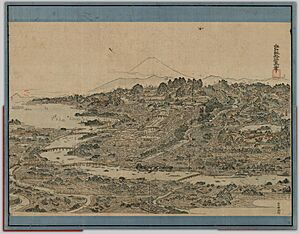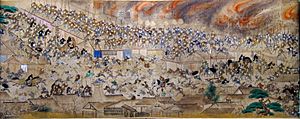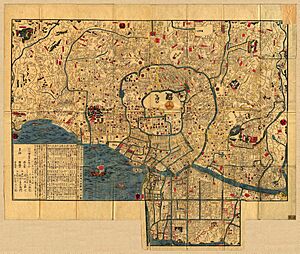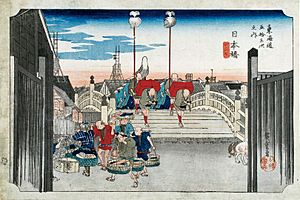Edo facts for kids
Quick facts for kids
Edo
江戸 (えど)
|
|
|---|---|
|
Former city
|
|
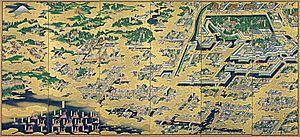
Folding screen view of Edo in the 17th century, showing Edo Castle on the upper right corner
|
|
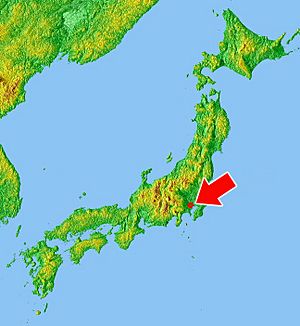
Location of the former city of Edo
|
|
| Country | Japan |
| Province | Musashi |
| Edo Castle built | 1457 |
| Capital of Japan (De facto) | 1603 |
| Renamed Tokyo | 1868 |
| Population
(1721)
|
|
| • Total | 1,000,000 |
Edo (Japanese: 江戸, lit. '"bay-entrance" or "estuary"'), also known as Jedo, Yedo or Yeddo, was the old name for Tokyo. It started as a castle town built around Edo Castle in Musashi Province.
From 1603, Edo became the main capital of Japan, even if not officially. This was because the Tokugawa shogunate (Japan's military government) was based there. Under the Tokugawa family, Edo grew into one of the largest cities in the world. By 1721, about 1 million people lived there.
In 1868, after a big change called the Meiji Restoration, the government renamed Edo as Tokyo (東京, meaning "Eastern Capital"). The Emperor then moved from the historic capital of Kyoto to Tokyo. The time when the Tokugawa family ruled Japan (from 1603 to 1868) is known as the Edo period.
Contents
History of Edo: From Village to Capital
Early Days of Edo
Before the 10th century, Edo was not often mentioned in history books. There were only a few small settlements in the area. The name "Edo" first appeared in the Azuma Kagami chronicles during the Heian period.
Edo began to grow in the late 11th century. A family branch called the Chichibu clan settled there. A descendant, Edo Shigetsugu, built a fortified home, which later became Edo Castle. His son, Edo Shigenaga, became a warrior for the Kamakura shogunate.
In 1456, a leader named Ōta Dōkan started building a castle on the old Edo clan site. Dōkan lived in the castle until he was killed in 1486. Under Dōkan, Edo grew into a jōkamachi (castle town). It had good water connections to other parts of Japan. The castle was next to a cove (now Hibiya Park) that opened into Tokyo Bay.
After Dōkan's death, the castle was taken over by the Later Hōjō clan. In 1590, Toyotomi Hideyoshi defeated the Hōjō clan. He gave the Kanto area to his officer, Tokugawa Ieyasu, who then made Edo his home.
Edo Under the Tokugawa Shogunate
Tokugawa Ieyasu became the most powerful leader in Japan after winning the Battle of Sekigahara in 1600. In 1603, he officially started the Tokugawa shogunate. He set up his main office at Edo Castle. This made Edo the center of political power and the unofficial capital of Japan. The official capital, where the emperor lived, was still Kyoto.
Edo grew from a small fishing village in 1457 to the world's largest city by 1721. It had an estimated population of 1 million people.
Edo often suffered from terrible fires. The Great Fire of Meireki in 1657 was the worst. About 100,000 people died, and a huge part of the city burned down. The fire destroyed the main tower of Edo Castle, which was never rebuilt. After this, city planners made changes to help prevent future fires. They added empty spaces and wider streets. Reconstruction also expanded the city east of the Sumida River. Many daimyo (feudal lords) residences were moved to create more space. During the Edo period, there were about 100 major fires. Most started by accident and spread quickly through wooden homes.
In 1868, the Tokugawa shogunate was overthrown during the Meiji Restoration. Supporters of Emperor Meiji ended Edo's role as the unofficial capital. However, the new Meiji government soon renamed Edo to Tōkyō (東京, "Eastern Capital"). The city became the formal capital of Japan when the emperor moved his home there.
How Edo Was Built: Urban Planning
Soon after the shogunate began, big construction projects started in Edo. These projects changed the city's landscape a lot. The shogunate used a program called Tenka-Bushin (天下普請), where daimyō (feudal lords) from all over Japan helped with civil works.
The Hibiya cove, facing the castle, was filled in after Ieyasu arrived. The Hirakawa River was rerouted, and many protective moats and canals were dug. This helped prevent floods. Land was also reclaimed from the bay, creating new areas like Tsukiji. East of the city, a large network of canals was built.
Getting fresh water was a big challenge. Wells often provided salty water because the city was on an estuary. So, a system of canals and underground wooden pipes was built. These brought fresh water from the western side of the city and the Tama River. Some of this system was used until the 20th century.
City Layout: A Castle Town
Edo was designed as a castle town around Edo Castle. The castle was located on the edge of the Musashino Terrace.
The area right around the castle was for samurai and daimyō homes. Their families lived in Edo as part of the sankin-kōtai system. This system required daimyō to travel to Edo every other year. Their homes were carefully placed based on their status. This arrangement for the samurai class made Edo unique. Unlike Kyoto or Osaka, Edo had a huge samurai population. Kyoto was known for its Imperial Court and temples. Osaka was a business center, full of merchants. In Edo, samurai and daimyō homes covered up to 70% of the city.
East and northeast of the castle lived the Shomin (庶民, "regular people"), including merchants. This area, called Shitamachi (下町, "lower town"), was much more crowded. It was organized into many gated communities called machi (町, "town" or "village"). Shomin also lived along the main roads leading in and out of the city. The Sumida River, then called the Great River (大川, Ōkawa), ran along the city's eastern side. The shogunate's official rice warehouses and other government buildings were here.
The Nihonbashi bridge (日本橋, lit. "bridge of Japan") was the center of the city's business. It was also the starting point for the main roads of Japan, making it the unofficial "center of the country." Fishermen, craftspeople, and shopkeepers worked here. Shippers managed boats that brought goods from Osaka and other cities.
The northeast part of the city was thought to be unlucky in traditional beliefs. So, many temples, like Sensō-ji and Kan'ei-ji, were built there to protect the city from evil. A path and canal led from the Sumida riverbank to the Yoshiwara pleasure district. This district was rebuilt in a more distant location after the Great Fire of Meireki.
Temples and shrines covered about 15% of the city's area. They were spread out, but many were in the northeast. Another important temple, Zōjō-ji, was located south of the castle.
Homes in Edo: Where People Lived
Samurai and Daimyō Homes
The homes of samurai and daimyō varied greatly in size. Some daimyō had several homes in Edo. The upper residence (上屋敷, kami-yashiki) was the main home. It was used for official duties and was convenient for traveling to the castle. It also served as the daimyō's embassy in Edo. The shogunate did not have power inside these homes, so they could also be places of refuge.
The middle residence (中屋敷, naka-yashiki), a bit further from the castle, could house the lord's heir or servants. It could also be a secret hiding place. The lower residence (下屋敷, shimo-yashiki), if there was one, was on the edge of town. It was more of a pleasure retreat with gardens. It could also be used if a fire destroyed the city. Some powerful daimyō's homes were huge, covering many acres. Maintaining these homes was very expensive. Samurai serving a specific clan usually lived in their lord's residence.
Hatamoto samurai, who served the Shogun directly, had their own homes. These were usually located behind the castle on the western side, in the Banchō area.
Townspeople's Homes (Shonin)
Most townspeople, or shonin, lived in shared wooden buildings called nagaya (長屋, litt. "Long house"). These had many rooms and were organized into enclosed machi (町, "town" or "village"). Each machi had shared facilities like wells (connected to the city's water system), trash areas, and communal bathrooms. A typical machi was rectangular and could house hundreds of people.
The machi had a curfew at night. Gates called kidomon (木戸門) would close and be guarded. These gates opened onto the main street (表通り, omote-dori) of the machi. Two-story buildings and larger shops, for higher-ranking people, faced the main street. Smaller streets, Shinmichi (新道), also had two-story buildings with shops on the first floor and living areas on the second. These were for wealthier residents. Very narrow streets, called roji (路地), led deeper into the machi. Here, single-story nagayas, called uranagayas (裏長屋, litt. "backstreet long houses"), were located. These back homes had smaller rooms and rentals for lower-ranked shonin.
Edo was nicknamed the City of 808 towns (江戸八百八町, Edo happyaku yachō). This shows how many different communities there were. By the 18th century, there were actually closer to 1,700 such communities.
See also
 In Spanish: Edo para niños
In Spanish: Edo para niños


